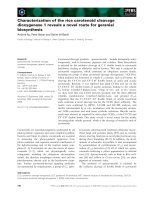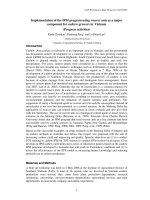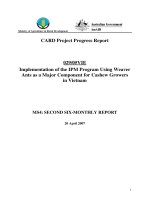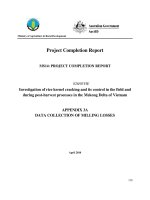Card Project Progress Report: Implementation of the IPM program using weaver ants as a major component for cashew growers in Vietnam " MS2 pdf
Bạn đang xem bản rút gọn của tài liệu. Xem và tải ngay bản đầy đủ của tài liệu tại đây (70.83 KB, 7 trang )
Ministry of Agriculture & Rural Development
CARD Project Progress Report
029/05/VIE
Implementation of the IPM program using
weaver ants as a major component for
cashewgrowers in Vietnam
MS2: Baseline Survey
Professor Dr. Pham Van Bien
Institute of Agricultural Science of South Vietnam
Dr Keith Christian and Dr Renkang Peng
Charles Darwin University
28 August 2006
1
Summary
A baseline survey was successfully conducted in eight main cashew growing
provinces using a standard questionnaire. The survey concentrated on six aspects:
1. Farmers’ opinion towards the cashew IPM program using weaver ants as a
major component,
2. Women’s role in cashew cultivation,
3. Current cashew farming status,
4. Effect of pesticides on farmers’ health and farm environment,
5. Farmers’ knowledge of cashew insect pests and diseases and their natural
enemies, and
6. Weaver ant status and farmers’ opinion of them.
The results are summarised below.
A total of 212 cashew farmers were interviewed, and 206 farmers were keen to
participate in our cashew IPM training. The FFS approach adopted by this project is
very welcome, and 90% of farmers expressed their preference of the FFS training
over other methods.
In current cashew production, women have played a very important part, and
their role in cashew orchard management will be further promoted by this project.
The majority of cashew growers are small holders, having about 2 ha of
orchards with an average tree age ranging from 6 years (from grafted materials) to 12
years (from seeds). Cashew apples were generally not used. Cashew nut yield was
about 1400 kg/ha in 2005 and 1000 kg/ha in 2006. For orchards with grafted
materials, costs were VND383,903, VND251,475 and VND1,500,250 for
insecticides, fungicides and chemical fertilizers respectively. For orchards grown
from seeds, costs were VND367,096, VND206,722 and VND1,222,886 for
insecticides, fungicides and chemical fertilizers respectively. Fertilizers were used by
84% of farmers 1 to 3 times a year, and most of them used chemical fertilizers only.
Insecticides and fungicides were used by 83% and 56% of farmers respectively. The
mean frequency was 2.5 times (ranging from 1 to 6 times) per year for insecticides,
and 2.2 times (ranging from 1 to 4 times) per year for fungicides. It was found that
most farmers did not use pesticides properly.
With regard to other farming practices, the majority of farmers controlled
weeds either by using herbicides or by physical cutting. Pruning was also practiced by
most farmers, but the way they did it was not appropriate in most orchards. Mulching
and irrigation were generally not practiced.
Pesticide spray has already caused health problems in farmers and their
animals, and problems with the environment. This project will focus on this issue to
improve farmers’ health and the environment.
Farmers’ knowledge about the insect pests and diseases and their natural
enemies in their own cashew orchards is poor.
Most orchards had weaver ants, but their populations were very low due to
insecticide application. Most farmers (92%) were familiar with weaver ants, and 50%
2
of them regarded the ants as beneficial. Based on these data, extensive and intensive
training about the biology of the ant is crucial for this project.
All the data obtained in this survey will be used for a comparison between
‘before’ and ‘after’ the implementation of this cashew IPM project.
1. Farmers’ opinion towards the cashew IPM program using weaver ants as
a major component
The baseline survey was conducted by TOT trainees in their own provinces using a
standard questionnaire (Appendix 1), so that the TOT trainees were aware of the
major problems cashew smallholders have in cashew production and what problems
the farmers think need to be resolved. A total of 212 cashew farmers in 8 major
cashew growing provinces (Binh Phuoc, Dac Lac, Dak Nong, Binh Duong, Ninh
Thuan, Dong Nai, Binh Thuan, Ba Ria Vung Tau) in Vietnam were interviewed, and
206 farmers expressed their interest in this program and were keen to participate in
the FFS training. Of the 6 farmers that did not want to participate in the FFS training,
one wanted to switch from cashew to rubber due to the current higher rubber price,
one did not want to use weaver ants, and four could not afford the time for the FFS
but they would use the IPM program in their orchards if the IPM project is successful.
The main goals of those farmers who were willing to have the FFS training were:
(1) to increase yield using integrated methods of pest control and farming
strategies,
(2) to improve the farm environment through reduction of insecticide use, and
(3) to get more experience in cashew cultivation.
This result shows that our cashew IPM project meets the cashew farmers’
requirements.
When farmers were asked about the best ways for them to learn new technology, 90%
of farmers listed FFS training, 60% listed farmers’ meeting, 40% listed demonstration
plots, 36% listed TV program, 30% listed leaflets and almost no farmers were
interested in posters and magazines (Fig. 1). This suggests that our approach of
implementing the cashew IPM program through FFS is very well welcome by cashew
growers. Posters we proposed to make for farmers may need to be altered.
3
0
20
40
60
80
100
120
140
160
180
200
Poster
L
e
afl
e
t
Ra
dio
T
V
News paper
Magazine
F.F.S
.
F.
me
e
t
i
n
g
De
mon
s
t
r.
No. of votes
Figure 1. Farmers’ response towards 9 learning methods to acquire new technology.
2. Women’s role in cashew cultivation
Women currently play a very important part in cashew production. Table 1 shows that
8% of cashew orchards are managed by women, 70% are jointly managed by men and
women and 22% by men. The women have had an average of 10 year experience in
cashew cultivation, which is similar to men (Table 1). Because the weaver ant
technology is not physically strenuous and it does not involve toxic insecticide sprays,
it could be used to further promote women’s participation in smallholder’s cashew
production.
Table 1. Labour partition and experience in cashew cultivation.
Orchards
managed by
No. of orchards Proportion to the
total (%)
Experience with
cashews (years)
Men only 45 22 10.4 + 4.8
Both men and
women
145 70 10.4 + 5.0
Women only 16 8 10.7 + 7.0
Total 206 100
3. Current cashew farming status
Based on this baseline survey, the majority of cashew growers were small holders,
having about 2 ha of orchards with the average tree age being 6 years (for grafted
materials) and 12 years (for trees produced from seeds) (Table 3). Cashew nut yield
was about 1400 kg/ha in 2005 and 1000 kg/ha in 2006 (Table 3). Cashew apples were
generally wasted: only 5% of farmers used apples either for sale or for their own
consumption.
Table 3. Orchard size, tree age and average yield in 2005 and 2006.
4
Yield (kg/ha)
Tree origin
in orchards
Orchard
size (ha)
Tree age
(years)
2005 2006
No. of
orchards
Graft 1.6 + 1.6 6.1 + 2.9 1388 + 602 1062 + 516 46
Seed 2.1 + 1.6 12.1 + 4.4 1500 + 833 1056 + 707 124
Traditionally, cashew growers in Vietnam did not use fertilizers, insecticides or
fungicides. Nowadays, 84% of them used fertilizers from 1 to 3 times a year (Table
4). Among these, most farmers used chemical fertilizers only, and a few farmers used
farm manure (Table 4). The time fertilizers were applied and the methods used were
mostly appropriate.
Table 4. Fertilizer use in small holders’ orchards.
Type of fertilizer No. of orchards No. of times /year Period of use
Chemical fertiliser
only
129 1.6 + 0.6 April-May;
September-October
Chemical fertilizer
& farm manure
41 2.0 + 1.3 April-May;
September-October
Farm manure only 4 2.0 + 0.0 April-May;
September-October
Of the 206 farmers interviewed, 171 (83%) and 116 (56%) used insecticides and
fungicides respectively. The frequency was 2.5 times (ranging from 1 to 6 times) per
year for insecticides, and 2.2 times (ranging from 1 to 4 times) per year for fungicides
(Table 5). The period of applying insecticides and/or fungicides was based on the
information obtained from Farmers’ clubs, Farmers’ organizations or neighbours,
rather than from their own orchard monitoring. Of 16 farmers who did not use
fertilizers but had similar tree age in their orchards, 6 of them who used insecticides
once a year did not get higher yield than the other 10 who did not use insecticides at
all (Table 6). This suggests that use of insecticides without monitoring is not
successful.
Table 5. Pesticide use in small holders’ orchards
Type No. of orchards No. of times /year Period of use
Insecticides 171 2.5 + 1.3 Pre-flowering,
flowering and nut
setting
Fungicides 116 2.2 + 1.0 Flowering + nut
setting
Table 6. Comparison of cashew nut yields between orchards with insecticide spray
and those without insecticide spray.
Mean yield + SD
(kg/ha)
No. of
orchards
Tree
age
(years)
Use of
fertilizers
Use of
fungicides
Use of
insecticides
2005 2006
10 8 - 11 No No No 955 + 422 710 + 690
6 8 - 12 No No Yes (once
a year)
927 + 629 583 + 343
5
For other farming practices, the majority of farmers controlled weeds either by using
herbicides or by physical cutting. Pruning was also practiced by most farmers, but the
way they did it was not appropriate in most orchards. Mulching and irrigation were
generally not practiced.
Costs of insecticides, fungicides and fertilizers are shown in Table 7. For orchards
with grafted materials, costs were VND383,903, VND251,475 and VND1,500,250 for
insecticides, fungicides and chemical fertilizers respectively. For orchards grown
from seeds, costs were VND367,096, VND206,722 and VND1,222,886 for
insecticides, fungicides and chemical fertilizers respectively. These data together with
yield data in Table 3 will be used for a comparison between ‘before’ and ‘after’ the
cashew IPM program implementation.
Table 7. Costs of insecticides, fungicides and chemical fertilizers.
Orchard type Insecticide
(VND/ha)
Fungicide
(VND/ha)
Chemical fertilizers
(VND/ha)
Graft 383,903 + 328,709 251,475 + 263,927 1,500,250 + 1,510,312
Seed 367,096 + 454,162 206,722 + 314,562 1,222,886 + 1,109,184
As costs of labour and equipment for application of pesticides and fertilizers greatly
differed among the farmers, the analyses of these categories could not be done.
4. Effect of pesticides on farmers’ health and farm environment
Pesticide spray has already caused health problems to farmers and their animals, and
problems with the environment. Of the 137 farmers who answered the question: ‘Any
poison symptoms to you or to your animals during or after the pesticide spray?’, only
28 (20%) farmers said no side effect occurred, and these farmers either used machine
sprayers or wore protected clothing. However, 109 (80%) farmers experienced
various kinds of poison symptoms during or after the insecticide operations, and these
included skin irritation, headache, vomiting, breathing difficulty, unconsciousness,
sneezing, loss of appetite, dizziness, chest pains and/or tiredness. Most of these
farmers used small back-pack sprayers without suitable protective clothing. Apart
from this, some farmers mentioned that their animals, such as chicken and ducks,
were also affected.
When farmers were asked whether pesticide sprays cause environmental problems, 17
(8%) out of 198 farmers who addressed this question said “no effect”, but 181 (92%)
farmers said that pesticide spray had already caused adverse effects on the
environment, and this included pollution to water, soil and air, reduction of beneficial
insects, more frequent pest outbreaks, effect on farm animals and on their own health.
When farmers were asked whether they would continue to use pesticides, 81 (40%)
out of 202 farmers who answered this question said they would stop using pesticides.
The remaining 121 (60%) farmers expressed a complicated feeling that they do not
want to use pesticides, but they feel they have to because of so many insect pest
problems. Our project will concentrate on this issue to improve farmers’ health and
environmental quality.
6
5. Farmers’ knowledge of cashew insect pests and diseases and their natural
enemies
There were 182 farmers who addressed this issue. For insect pests and diseases, there
were 135 (74%) farmers who could recognise only one insect pest or disease, 36
(20%) farmers who knew two insect pests and diseases and only 11 (6%) farmers who
knew more than two insect pests and diseases.
With regard to the knowledge about natural enemies of cashew insect pests, of the
200 farmers who addressed this issue, 92 (46%) had no knowledge of the natural
enemies. Although 108 (54%) of the farmers put ‘yes’ for the question, most of them
only knew one or two groups of general natural predators such as spiders, ants,
ladybirds, preying mantids or birds. In Vietnam, there are at least 10 major insect
pests and three diseases as well as many important species of natural enemies such as
parasitoids and beneficial fungi in cashew orchards. These data clearly show that
farmers lack extensive knowledge about the insect pests and diseases and their natural
enemies. Our training program will concentrate on these issues to improve their
knowledge.
6. Weaver ant status and farmers’ opinion of them
Most orchards had weaver ants, but their populations were very low due to insecticide
application. Most farmers knew weaver ants, and regarded them as beneficial.
Because this project is to use weaver ants as a major component, we designed
particular questions about the presence or absence of the ants in their orchards and
farmers’ opinion of them. A total of 200 farmers answered these questions. There
were 15 orchards without weaver ants, and these orchards were sprayed more than
three times per year. These owners knew nothing about the ants. There were 185
orchards with weaver ants, and these orchards were either not sprayed or sprayed
either one and two times a year. The ant populations in most orchards were very low.
These orchard owners had different opinions about the ants: of 185 farmers, 58 (31%)
were not sure whether the ants were beneficial or harmful; 29 (15%) were negative,
saying that the ants were harmful because they disturbed harvest or pruning and they
protected mealy bugs; 98 (53%) were positive, claiming that the ants ate insect pests.
These data indicate that extensive and intensive training with the biology of the ant is
crucial, and that the demonstration orchards with established weaver ant colonies will
provide farmers with a full picture of how the ants can benefit them.
7









